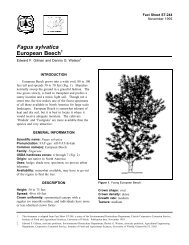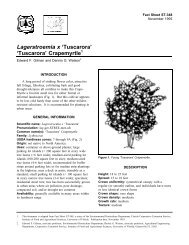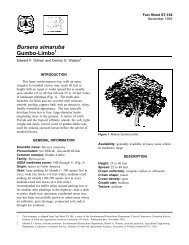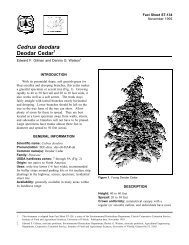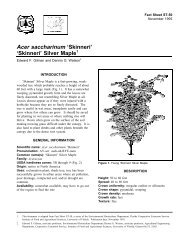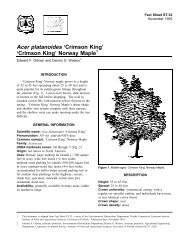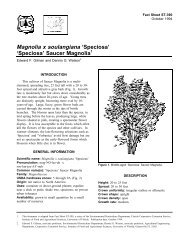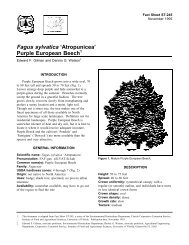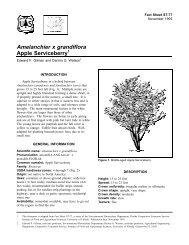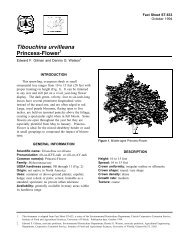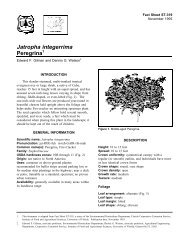GPN pdf - University of Florida
GPN pdf - University of Florida
GPN pdf - University of Florida
Create successful ePaper yourself
Turn your PDF publications into a flip-book with our unique Google optimized e-Paper software.
esearch<br />
U<br />
nlocking Pollination<br />
Jake Henny<br />
Mid-<strong>Florida</strong> Research & Education Center<br />
Apopka, Fla.<br />
Foliage plants are the focus <strong>of</strong> Jake<br />
Henny’s efforts at the Mid-<strong>Florida</strong><br />
Research and Education Center in<br />
Apopka. Henny still uses traditional<br />
methods for most <strong>of</strong> his breeding work<br />
and states that “unlocking pollination<br />
has been the key to all breeding work<br />
with the aroids.” His goal has been<br />
breeding new characteristics <strong>of</strong> foliar<br />
color, stem branching, cold hardiness,<br />
heat tolerance and disease resistance.<br />
Thirty years ago, Henny participated<br />
in collecting a variety <strong>of</strong> germplasm<br />
from the jungles: beautiful species <strong>of</strong><br />
dieffenbachia, aglaonema and anthurium.<br />
But the whole program mission<br />
<strong>of</strong> creating novel hybrids depended<br />
on pollen supply. The discovery that<br />
gibberellic acid induces blooming on<br />
demand cracked the fi eld wide open.<br />
The other key was fi nding that high relative<br />
humidity was necessary for pollen<br />
germination and seed set.<br />
To date, Henny has developed and<br />
released 28 foliage plant cultivars<br />
including new types <strong>of</strong> anthurium, dieffenbachia,<br />
aglaonema, heart-leaf philodendron<br />
(Philodendron scandens oxycardium)<br />
and pothos (Epipremnum aureum).<br />
Among the most successful has been<br />
Editors’ Note: This is the fi fth in a six-part series <strong>of</strong> articles highlighting<br />
the research being performed at the <strong>University</strong> <strong>of</strong> <strong>Florida</strong> in Gainesville.<br />
Breeding<br />
Brilliance<br />
The <strong>University</strong> <strong>of</strong> <strong>Florida</strong>’s breeding program involves a diverse array<br />
<strong>of</strong> projects spearheaded by a group <strong>of</strong> talented plant scientists.<br />
By Rosanna Freyre, Dave Clark,<br />
Zhanao Deng, Brent Harbaugh<br />
and Jake Henny<br />
The <strong>University</strong> <strong>of</strong> <strong>Florida</strong> has the largest university fl oriculture breeding program<br />
in the United States. Throughout its 60-year history, the program has become known<br />
for introductions <strong>of</strong> gladiolus, gypsophila, orchid, caladium and foliage varieties. The<br />
program has evolved to focus on foliage, lisianthus, gerbera, caladium, coleus, other<br />
bedding plants, and tropical fl owering and foliage landscape plants.<br />
Strengths <strong>of</strong> the program include the diversity <strong>of</strong> crops being addressed and the<br />
varied backgrounds <strong>of</strong> the scientists involved. Additionally, strong cooperation exists<br />
with commercial breeder companies and scientists within the university and at other<br />
schools. An important goal <strong>of</strong> the program is to develop young plant breeders needed<br />
by the commercial industries.<br />
the aglaonema Bay series, including<br />
‘Silver Bay’, ‘Golden Bay’, ‘Emerald Bay’,<br />
‘Diamond Bay’ and ‘Moonlight Bay’.<br />
These plants are easy to grow and make<br />
outstanding interior plants. The most<br />
recent release from 2008, ‘Mondo Bay’,<br />
is derived from an interspecifi c hybridization,<br />
and was selected for its high<br />
level <strong>of</strong> basal shoot branching, smaller,<br />
narrower leaves, arching plant form<br />
and attractive foliar variegation.<br />
In some foliage genera, sterility may<br />
prevent hybridization, as in heart-leaf<br />
philodendron. A mutation breeding<br />
program was initiated to develop<br />
unique forms <strong>of</strong> this important foliage<br />
plant. Heart-leaf philodendron proved<br />
to be quite responsive to irradiation,<br />
which led to the introduction <strong>of</strong> philodendron<br />
‘Frilly Philly’ in 2008. This cultivar<br />
has grown well and remained true<br />
to type in growth tests. Also, in tests<br />
simulating interiorscape conditions, its<br />
quality was rated good to excellent even<br />
after six months indoors. ‘Frilly Philly’<br />
can be grown as a hanging basket or<br />
totem. It should be grown with multiple<br />
cuttings per pot (at least fi ve to<br />
10 small tip cuttings per 4-inch pot)<br />
and will depend on container size and<br />
grower preference.<br />
Currently, Henny is evaluating several<br />
other induced mutations <strong>of</strong> heartleaf<br />
philodendron, pothos and gynura<br />
(velvet plant). ➧<br />
Aglaonema ‘Mondo Bay’<br />
Heart-leaf philodendron ‘Frilly Philly’<br />
28 <strong>GPN</strong> June 2009 www.gpnmag.com
esearch<br />
I<br />
mproving Resistance and Tolerance<br />
Zhanao Deng<br />
and Brent Harbaugh<br />
Gulf Coast Research and Education Center<br />
Balm, Fla.<br />
Drs. Deng and Harbaugh are located<br />
at the Gulf Coast Research and Education<br />
Center (GCREC) in Balm, near Tampa Bay.<br />
This is the location <strong>of</strong> the world’s leading<br />
caladium breeding program, which was<br />
under the leadership <strong>of</strong> Dr. Gary Wilfret for<br />
many years. Deng and Harbaugh now collaborate<br />
in its direction.<br />
In recent years, Deng and Harbaugh’s<br />
program’s priority has been to improve disease<br />
and stress tolerance, and to control a<br />
crop’s invasive traits. Disease resistance and<br />
stress tolerance have become increasingly<br />
important to commercial growers for costeffective,<br />
sustainable production and to the<br />
end customers for dependable performance.<br />
Invasive behaviors <strong>of</strong> some ornamental<br />
plants, including prolifi c seed production<br />
and a tendency to spread to natural areas,<br />
negatively impact the environment and have<br />
become a major concern to the industry.<br />
Specifi cally, focus has been on improving<br />
resistance to Fusarium tuber rot and<br />
Pythium root rot; resistance to powder<br />
mildew in gerbera; tolerance to sun burn<br />
and low temperatures in caladium; tolerance<br />
to high temperatures in lisianthus; and<br />
producing seedless, pollen-sterile lantana.<br />
Deng and Harbaugh have collaborated with<br />
plant pathologists to develop screening<br />
and selection techniques to fi nd sources <strong>of</strong><br />
resistance to pathogens. Similarly, they have<br />
screened germplasm to fi nd sources <strong>of</strong> low<br />
temperature tolerance in caladium, and <strong>of</strong><br />
high temperature tolerance in lisianthus.<br />
These traits are then patiently incorporated<br />
into new generations through hybridizing.<br />
Over the years, a number <strong>of</strong> cultivars with<br />
improved disease resistance and/or stress<br />
tolerance have been released. Caladium<br />
cultivars ‘<strong>Florida</strong> Moonlight’, ‘<strong>Florida</strong> Blizzard’,<br />
‘Garden White’, ‘<strong>Florida</strong> Red Ruffl es’<br />
and ‘<strong>Florida</strong> Sweetheart’ are commercially<br />
available. Another seven cultivars, ‘Angel<br />
Wing Dwarf White’, ‘Angel Wing Dwarf<br />
Tricolor’, ‘Dr. Brent’, ‘Summer Rose’, ‘Firecracker<br />
Red’, ‘Cranberry Star’ and ‘Berry<br />
Patch’, are currently being increased by the<br />
<strong>Florida</strong> caladium growers and should be<br />
available in the next one or two years for<br />
greenhouse growers.<br />
Harbaugh has released two new series <strong>of</strong><br />
lisianthus cultivars, ‘UF Double Joy’ and ‘UF<br />
Savanna’. They have demonstrated excellent<br />
heat tolerance and year-round fl owering<br />
capability, even in warm Southern states.<br />
The cultivars also were selected for basal<br />
branching and short stature; growth retardants<br />
are not required to produce pot plants,<br />
a big savings for greenhouse growers. Both<br />
the peninsula advantage.<br />
florida’s largest dedicated ltl foliage carrier<br />
<br />
<br />
<br />
<br />
<br />
<br />
<br />
<br />
<br />
<br />
<br />
<br />
<br />
<br />
<br />
full truckloads also available<br />
<br />
<br />
<br />
<br />
<br />
<br />
<br />
<br />
<br />
peninsula foliage, inc.<br />
(352)735-4687 x103<br />
<br />
no boxes required!<br />
<br />
<br />
<br />
<br />
<br />
<br />
<br />
<br />
<br />
<br />
Lisianthus ‘UF Double Joy Blue’<br />
series come in a variety <strong>of</strong> colors. ‘UF Double<br />
Joy’ is the fi rst series <strong>of</strong> double-fl owered<br />
pot lisianthus.<br />
‘UF Multifl ora Peach Bicolor’ is the fi rst<br />
gerbera cultivar specifi cally selected for<br />
powdery mildew resistance. More gerbera<br />
cultivars with improved powdery mildew<br />
resistance are in the works. Deng and Harbaugh<br />
also have investigated the genetic<br />
mechanisms responsible for lantana’s variation<br />
in seed and pollen production and are<br />
now producing environmentally friendly<br />
lantana cultivars. This year, a selection<br />
<strong>of</strong> about a dozen lantana breeding lines<br />
will be evaluated at four research sites in<br />
<strong>Florida</strong> to evaluate for ornamental potential<br />
and sterility.<br />
<br />
Write in 727<br />
Write in 750<br />
30 <strong>GPN</strong> June 2009 www.gpnmag.com
Success with Coleus<br />
Dave Clark<br />
<strong>University</strong> <strong>of</strong> <strong>Florida</strong><br />
Gainesville, Fla.<br />
Dave Clark is located at the main campus<br />
in Gainesville and is probably most recognized<br />
for his fl oriculture biotechnology<br />
research program, which was highlighted in<br />
March <strong>GPN</strong>. He started a traditional coleus<br />
breeding program in 2002 following a few<br />
serendipitous events. In discussions with<br />
commercial fl ower breeders, Clark realized<br />
there was a shortage <strong>of</strong> new fl ower breeders<br />
graduating from universities. In the age <strong>of</strong><br />
molecular biology, many academic breeders<br />
had retired and not been replaced, or were<br />
replaced with molecular biologists. Clark’s<br />
lab was certainly a part <strong>of</strong> that process, but<br />
since his days breeding regal pelargonium<br />
as a Penn State graduate student, he had<br />
always maintained a passion for breeding.<br />
At the same time, a new graduate student,<br />
Penny Nguyen, did not want to be a molecular<br />
biologist but wanted to breed fl owers.<br />
Timing is everything!<br />
To begin Nguyen’s research, she and<br />
Clark collected germplasm from several different<br />
plant species to assess the amount <strong>of</strong><br />
genetic variability available for making new<br />
varieties. They eventually settled on coleus.<br />
From the beginning, their primary goal<br />
has been to use tough selection criteria<br />
Cavities<br />
designed<br />
for growth!<br />
propagation tray manufacturer<br />
1.888.453.5961<br />
www.beaverplastics.com<br />
(<strong>Florida</strong> conditions) to develop vegetatively<br />
propagated coleus varieties for the mainstream<br />
U.S. bedding plant market. The main<br />
interests <strong>of</strong> their program have centered on<br />
several traits that are important for making<br />
an excellent summer annual bedding plant<br />
that anyone can grow well: late or no fl owering;<br />
consistent garden performance in<br />
heat/sun; foliage color stability in full sun<br />
and shade; better branching and trailing<br />
habit; disease tolerance; and novel foliage<br />
color, shape and size.<br />
Every year, they develop elite cultivars<br />
using recurrent mass selection techniques<br />
using a yearly cycle the for selection process.<br />
With this process, they have been able<br />
to maintain an excellent pool <strong>of</strong> coleus germplasm<br />
that continues to produce exciting<br />
new varieties that perform well in summer<br />
gardens across the United States. Current<br />
commercial coleus cultivars include<br />
‘Twist ‘n’ Twirl’, ‘Royal Glissade’, ‘Electric<br />
Lime’, ‘Frilly Milly’, ‘Splish Splash’, ‘Pineapple<br />
Splash’, ‘Lancelot Velvet Mocha’,<br />
‘Lemon Sunsation’, ‘Big Red Judy’ and<br />
‘Limon Blush’. May through June is a good<br />
time to see coleus plants at the <strong>University</strong><br />
<strong>of</strong> <strong>Florida</strong>.<br />
Clark also is helping to cultivate the next<br />
generation <strong>of</strong> ornamental plant breeders:<br />
Nguyen’s research on the genetics <strong>of</strong> growth<br />
habit in coleus appeared in the December<br />
2008 issue <strong>of</strong> the Journal <strong>of</strong> Heredity. ➧<br />
‘Pineapple Splash’<br />
‘Royal Glissade’<br />
research<br />
Write in 753<br />
Write in 728<br />
www.gpnmag.com June 2009 <strong>GPN</strong> 31
esearch<br />
B<br />
reeding New Tropicals<br />
Rosanna Freyre<br />
<strong>University</strong> <strong>of</strong> <strong>Florida</strong><br />
Gainesville, Fla.<br />
Rosanna Freyre is the “new kid on the<br />
block,” having been at the <strong>University</strong> <strong>of</strong><br />
<strong>Florida</strong> only since September 2006. Previously,<br />
she was at the <strong>University</strong> <strong>of</strong> New<br />
Hampshire breeding vegetatively propagated<br />
annuals. She had maintained a successful<br />
partnership since 2002 with Pleasant<br />
View Gardens and Proven Winners, which<br />
led to the release <strong>of</strong> four Wildcat anagallis,<br />
three Endless browallia and nolana ‘Loma<br />
Blanca’. Now, Freyre is mainly devoted to<br />
research and breeding <strong>of</strong> ornamentals, has<br />
been involved in the management <strong>of</strong> the<br />
university’s trial gardens and conducts private<br />
fi eld and container performance evaluations<br />
for fl oriculture breeding companies.<br />
Moving to the warmer climate <strong>of</strong> <strong>Florida</strong><br />
meant that Freyre had to learn a new plant<br />
palette and change her breeding focus.<br />
She began by asking the advice <strong>of</strong> <strong>Florida</strong><br />
growers and also looked at underutilized<br />
plants with exceptional trial performance<br />
at the university. Consequently, one <strong>of</strong> her<br />
new areas <strong>of</strong> research is breeding <strong>of</strong> tropical<br />
foliage plants for the landscape, such<br />
as sanchezia, strobilanthes, pseuderanthemums,<br />
alternanthera and iresine.<br />
In addition to classical breeding using<br />
PolAIR <br />
Time To To Chill Out!<br />
The highly efficient PolAIR High Pressure Fog System<br />
generates billions <strong>of</strong> micron-sized droplets which flash<br />
evaporate upon contact with the air, providing balanced and<br />
instant cooling – even in areas <strong>of</strong> high humidity. PolAIR High<br />
Pressure Fog Systems are custom designed and installed with<br />
little or no structural modifications.<br />
hybridization and selection cycles, Freyre<br />
has incorporated mutation breeding to<br />
her program using irradiation to create<br />
variants in foliage color, morphology and<br />
growth habit. Sports are propagated vegetatively<br />
to stabilize the desired trait, and<br />
the new plants are evaluated in the greenhouse,<br />
in the fi eld under full sun and under<br />
30 percent shade. An important selection is<br />
for plant compactness, which should result<br />
in less use <strong>of</strong> plant growth regulators. This<br />
summer, she also will be conducting a trial<br />
under different irrigation regimes to select<br />
plants with reduced water requirement,<br />
which is an important consideration under<br />
current water restrictions in Southern<br />
states. There has been considerable interest<br />
by growers around the United States on<br />
breeding lines developed by this new program,<br />
and many <strong>of</strong> them are already under<br />
commercial trial evaluation.<br />
A second focus for Freyre’s breeding<br />
research is on Ruellia brittoniana (Mexican<br />
petunia), a popular landscape plant in the<br />
South that is considered invasive because<br />
<strong>of</strong> its prolifi c seed production and high<br />
germination rates. Currently, the only<br />
sterile cultivar commercially available is<br />
purple-fl owered ‘Purple Showers’. Freyre<br />
is currently collaborating with <strong>University</strong><br />
<strong>of</strong> <strong>Florida</strong> colleagues Sandy Wilson at Fort<br />
Pierce, Zhanao Deng at Balm and Gary<br />
Knox at Quincy, to develop other sterile<br />
PolAIR EZ-Cool<br />
An industry first in pad cooling, the PolAIR EZ-Cool is a<br />
proprietary system, manufactured by VAL-CO. With a unique,<br />
raised ribbed pad tray, molded directly into the trough. The pad<br />
is elevated above the drain holes allowing for 100% drainage<br />
with no spill-over. Available in flush mount or extended mount.<br />
Extended mount keeps the pad 10” <strong>of</strong>f the wall.<br />
Contact us us today!<br />
2710 Division Hwy, PO Box 8<br />
New Holland, PA 17557<br />
Phone: 800.433.1819<br />
Fax: 717.355.2505<br />
Email: hortna@valcompanies.com<br />
Website: www.valcogreenhouse.com<br />
#1<br />
in System<br />
Performance<br />
Ruellia brittoniana<br />
ruellia cultivars as well as lantana, nandina<br />
and stachytarpheta. Their methods include<br />
irradiation <strong>of</strong> seeds and seedlings, and<br />
induction <strong>of</strong> polyploidy (plants with multiple<br />
chromosome sets) to create sterile triploids.<br />
Freyre also has compiled an extensive<br />
ruellia germplasm collection, aiming to<br />
create interspecifi c hybrids that are sterile<br />
and have good ornamental potential. This<br />
summer, she will be evaluating more than<br />
1,000 ruellia hybrids and mutants in the<br />
fi eld. She also will be evaluating a number<br />
<strong>of</strong> new genera for ornamental potential to<br />
start new breeding projects. <strong>GPN</strong><br />
Rosanna Freyre is research scientist at the<br />
<strong>University</strong> <strong>of</strong> <strong>Florida</strong> in Gainesville. She can<br />
be reached at rfreyre@ufl .edu.<br />
LearnMore<br />
For more information related to this article,<br />
go to www.gpnmag.com/lm.cfm/gp060903<br />
Visit the newly designed,<br />
easy-to-use<br />
www.gpnmag.com<br />
Talk to editorial<br />
director Tim Hodson<br />
Breaking news<br />
Career Center<br />
Easy-to-use buyer’s guide<br />
and much more!<br />
Write in 725<br />
32 <strong>GPN</strong> June 2009 www.gpnmag.com<br />
•<br />
•<br />
•<br />
•<br />
•<br />
•<br />
•<br />
Visit www.gpnmag.com today!<br />
Zones<br />
Automation<br />
Disease<br />
Management<br />
•<br />
•<br />
•<br />
Poinsettias<br />
Structures<br />
Water Quality<br />
<strong>GPN</strong> <strong>GPN</strong><br />
g r e e n h o u s e p r o d u c t n e w s<br />
WWW.<strong>GPN</strong>MAG.COM<br />
W



